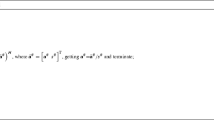Abstract
An enhanced eigenspace-based beamformer (ESB) derived using the minimum sensitivity criterion is proposed with significantly improved robustness against steering vector errors. The sensitivity function is defined as the squared norm of the appropriately scaled weight vector and since the sensitivity function of an array to perturbations becomes very large in the presence of steering vector errors, it can be used to find the best projection for the ESB, irrespective of the distribution of additive noises. As demonstrated by simulation results, the proposed method has a better performance than the classic ESBs and the previously proposed uncertainty set based approach.










Similar content being viewed by others
References
Capon, J. (1969). High-resolution frequency-wavenumber spectrum analysis. Proceedings of the IEEE, 57(8), 1408–1418.
Carlson, B. D. (1988). Covariance-matrix estimation errors and diagonal loading in adaptive arrays. IEEE Transactions on Aerospace and Electronic Systems, 24(4), 397–401.
Cox, H., Zeskind, R. M., & Owen, M. M. (1987). Robust adaptive beamforming. IEEE Transactions on Acoustics Speech and Signal Processing, 35(10), 1365–1376.
Feldman, D. D., & Griffiths, L. J. (1994). A projection approach for robust adaptive beamforming. IEEE Transactions on Signal Processing, 42(4), 867–876.
Li, J., Stoica, P., & Wang, Z. S. (2003). On robust Capon beamforming and diagonal loading. IEEE Transactions on Signal Processing, 51(7), 1702–1715.
Li, J., Stoica, P., & Wang, Z. S. (2004). Doubly constrained robust Capon beamformer. IEEE Transactions on Signal Processing, 52(9), 2407–2423.
Rübsamen, M., & Pesavento, M. (2013). Maximally robust Capon beamformer. IEEE Transactions on Signal Processing, 61(8), 2030–2041.
Somasundaram, S. (2011). Reduced dimension robust Capon beamforming for large aperture passive sonar arrays. IET Radar, Sonar and Navigation, 5(7), 707–715.
Van Trees, H. L. (2002). Optimum array processing, part IV of detection, estimation, and modultion theory. New York: Wiley.
Vorobyov, S. A., Gershman, A. B., & Luo, Z. Q. (2003). Robust adaptive beamforming using worst-case performance optimization: A solution to the signal mismatch problem. IEEE Transactions on Signal Processing, 51(2), 313–324.
Wen, F. X., Ng, B. P., & Reddy, V. (2013). Extending the concept of IIR filtering to array processing using approximate spatial IIR structure. Multidimensional Systems and Signal Processing, 24(1), 157–179.
Yang, J., Liao, G. S., Li, J., Lei, Y., & Wang, X. (2015). Robust beamforming with imprecise array geometry using steering vector estimation and interference covariance matrix reconstruction. Multidimensional Systems and Signal Processing. doi:10.1007/s11045-015-0350-7.
Zhang, L., & Liu, W. (2012). Robust forward backward based beamformer for a general-rank signal model with real-valued implementation. Signal Process, 92, 163–169.
Zhang, Z. Y., Liu, W., Leng, W., Wang, A. G., & Shi, H. P. (2016). Interference-plus-Noise covariance matrix reconstruction via spatial power spectrum sampling for robust adaptive beamforming. IEEE Signal Processing Letters, 23, 121–125.
Zhang, X. R., Liu, Z. W., Xu, Y. G., & Liu, W. (2015). Adaptive tensorial beamformer based on electromagnetic vector-sensor arrays with coherent interferences. Multidimensional Systems and Signal Processing, 26(3), 803–821.
Zhang, Y., & Ng, B. P. (2010). MUSIC-like DOA estimation without estimating the number of sources. IEEE Transactions on Signal Processing, 58(3), 1668–1676.
Zhang, W., Wang, J., & Wu, S. (2013). Robust Capon beamforming against large DOA mismatch. Signal Processing, 93(4), 804–810.
Zhang, W., Wang, J., & Wu, S. (2013). Robust minimum variance multiple-input multiple-output radar beamformer. IET Signal Processing, 7(9), 854–862.
Zhang, W., Wang, J., & Wu, S. (2014). Adaptive multiple-input multiple-output radar beamforming based on direct data domain approach. IET Radar, Sonar and Navigation, 8(6), 632–638.
Zhao, Y., & Liu, W. (2013). Robust fixed frequency invariant beamformer design subject to norm-bounded errors. IEEE Signal Processing Letters, 20(2), 169–172.
Author information
Authors and Affiliations
Corresponding author
Rights and permissions
About this article
Cite this article
Wang, J., Zhang, W. & Liu, W. Minimum sensitivity based robust beamforming with eigenspace decomposition. Multidim Syst Sign Process 29, 687–701 (2018). https://doi.org/10.1007/s11045-016-0424-1
Received:
Revised:
Accepted:
Published:
Issue Date:
DOI: https://doi.org/10.1007/s11045-016-0424-1




